In this article, we cover the four main types of UL life safety dampers: fire, smoke, combination fire-smoke, and ceiling radiation dampers. Learn where life safety dampers go, what they do, and how they protect your building during a fire.
Life Safety Dampers & Passive Fire Protection
Passive Fire Protection (PFP) systems contain fire and smoke to predetermined areas of a building, to prevent it from quickly spreading through the rest of the building. The PFP system uses life safety dampers installed in HVAC ducts and wall penetrations. There are four types of UL life safety dampers: fire dampers, smoke dampers, combination fire-smoke dampers, and ceiling radiation dampers.
Buildings will require life safety dampers in specific areas, such as a fire barrier, to create special zones for fire and smoke containment. Each damper type will perform a particular function in a complete PFP system, but their purpose is the same: to give people time to evacuate the building. In this article, we will discuss the four life safety dampers and how they work in an emergency.
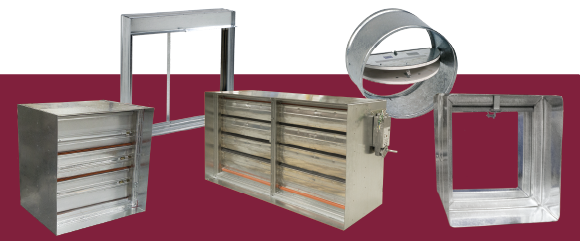
1.) Fire Dampers
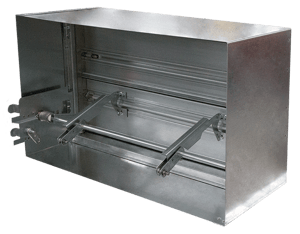
In PFP systems, fire barriers contain flames to a specific area of the building. These barriers will have openings (penetrations) like HVAC vents, to allow for ventilation during standard operation.
Flames will infiltrate unprotected penetrations and pass through the barrier into other parts of the building. Fire dampers complete the fire barrier by protecting these penetrations. Each fire damper undergoes rigorous testing in a UL-approved laboratory, under UL 555, to be approved for use as a fire damper. Fire dampers will come in two distinctive styles, with multiple blades or with a curtain blade.
Fire dampers with multiple blades will resemble air control dampers: they have blades that rotate along a central axis, which are all contained in the metal frame. Multi-blade fire dampers can also have an actuator to control blade movement. All life safety dampers will use blade seals of a distinct color than air control dampers. This makes it easier to differentiate between them when installed in the ductwork. The fundamental difference is their function. Unlike control dampers, fire dampers will only close when temperatures rise above a certain threshold.
Each fire damper will have a heat response device (HRD) that holds the blades in the open position. Once temperatures in the duct exceed the HRD’s threshold, the device will release the blades to close off the duct. Multi-blade fire dampers will use actuators equipped with a thermodisc, an electrical HRD that disrupts the actuator's power supply. When the actuator loses power, springs inside the actuator will drive the damper blades to the closed position. This type of closure is called “power open–spring close”.
Curtain Fire Dampers
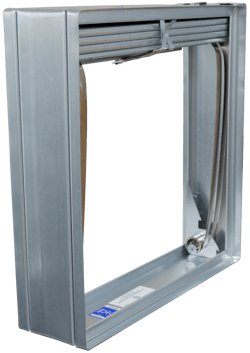
Curtain blade fire dampers use several interlocking blades that form a curtain. A fusible link holds this curtain to the damper's top when open, keeping the air stream free of obstructions. During a fire, the curtain blade falls across the damper’s opening and closes off the duct. Special damper sleeves, C-Style, can conceal the blade stack and further increase the damper’s free area up to 100%.
A fusible link holds the curtain blade in place until temperatures reach its rated threshold. Breaking this link releases the curtain blade, closing the damper. For vertically mounted dampers, the curtain blade will fall over the damper’s opening. For horizontally mounted dampers, the curtain will be driven across the opening by springs. Special latches lock the blade in position. These latches keep the damper closed during a fire event.
All fire dampers are static or dynamic. This refers to whether the damper can close against air flow. A dynamic fire damper can close on an air stream even if fans are running (dynamic air conditions). A static fire damper will only close if air flow has stopped (static air conditions). Choosing one over the other will depend on your fans. If your fans stop at the start of a fire, then static fire dampers will work for your system. If fans stay powered, you will need to use dynamic fire dampers.
Fire dampers can be static or dynamic, but smoke dampers and combination fire-smoke dampers will only be dynamic.
2.) Smoke Dampers
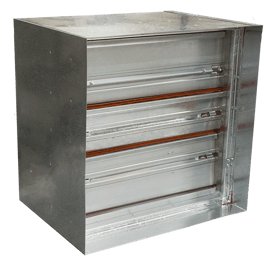
Noxious fumes can spread through your building by infiltrating the ventilation openings in your walls and ceiling. Smoke dampers contain these fumes and prevent them from spreading through your HVAC system.
Smoke dampers are multi-blade dampers that are similar in design to standard control dampers, but with a few key differences. These dampers have seals on the edges of each blade and along the damper's jambs, to prevent smoke from passing through the closed damper.
Each smoke damper will have a smoke detection system tied to the damper’s actuator, to check the air stream for signs of noxious fumes. Upon smoke detection, the detector will send an electrical signal to the actuator, closing the damper and preventing further smoke spread into the HVAC system. The building's fire alarm system can also trigger the actuators to close the damper.
Every smoke damper undergoes a multitude of tests under UL 555S, including an air leakage test. Test labs measure air passing through the closed damper at elevated temperatures and across multiple sizes. By comparing these measurements to the largest size damper, test labs determine the damper’s Leakage Class, from I to III. The Leakage Class shows the minimum amount of air allowed through the closed damper at a given air pressure:
- Leakage Class I: 8 cfm/sq.ft. @ 4.5 in. w.g. or 11 cfm/sq.ft. @ 8.5 in. w.g.
- Leakage Class II: 20 cfm/sq.ft. @ 4.5 in. w.g. or 28 cfm/sq.ft. @ 8.5 in. w.g.
- Leakage Class III: 80 cfm/sq.ft. @ 4.5 in. w.g. or 112 cfm/sq.ft. @ 8.5 in. w.g.
Typically, noxious fumes in the airstream keep smoke dampers closed, but sometimes they may need to reopen. First responders will need to access all areas of the building, including those areas filled with smoke and noxious fumes. A smoke control system allows an operator to open and close smoke dampers to redirect smoke into an unoccupied part of the building. From there, they can continue fighting the fire without having to worry about dangerous smoke.
Smoke dampers are a vital part of a passive fire protection system. Along with fire dampers, smoke dampers provide precious time for first responders to combat the fire and for occupants to safely exit the building. Each life safety damper is important, but there is a certain type that can protect from both elements.
3.) Combination Fire-Smoke Dampers
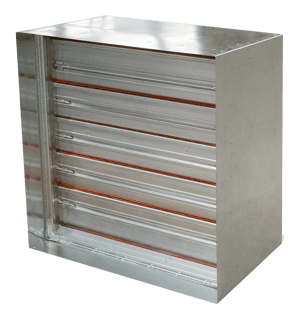
Combination fire-smoke dampers perform as both fire and smoke dampers. These dampers stop flames from penetrating fire barriers and prevent smoke from spreading through the HVAC system. Combination fire-smoke dampers will always have multiple blades tied to an actuator.
Manufacturers will equip the damper’s actuator with a heat response device and tie it to a smoke detection system, to close the damper at first signs of noxious fumes or elevated temperatures. These dampers detect both hazardous elements, fire and smoke.
Combination fire-smoke dampers must meet UL 555 and UL 555S to be used for both scenarios. Since they meet both standards, you can use combination fire-smoke dampers for fire and smoke requirements. These dampers can be a versatile and cost-effective unit, providing passive fire protection to your building.
4.) Ceiling Radiation Dampers
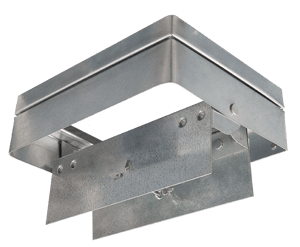
Ceiling radiation dampers provide specific protection. As their name implies, these dampers block radiant heat from entering the concealed space between floors. During a fire, the heat from the flames radiates into these areas and spark flames on higher floors.
If a fire breaks out in this space, it will be difficult to extinguish. Worse, a fire between floors will quickly weaken structural members and cause a catastrophic failure. Ceiling radiation dampers prevent the buildup of heat by closing off the penetration during a fire.
The typical ceiling radiation damper comprises two or four wing-style blades that are suspended in the open position with a fusible link. When the fusible link breaks, the blades will come down over the damper opening and seal it off. Ceiling radiation dampers have insulated or uninsulated blades. Ceiling radiation dampers contain heat and prevent it from sparking fires in the crucial structural points between floors.
Need life safety dampers for your next project? Air Balance offers static and dynamic fire dampers to meet your fire safety requirements. Looking for something else? Contact us by clicking on the button below.
.webp?width=91&height=70&name=MCDLG%20Logo%20(Resize).webp)
.webp)





